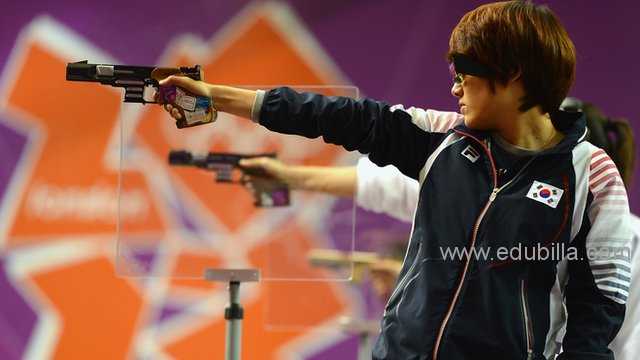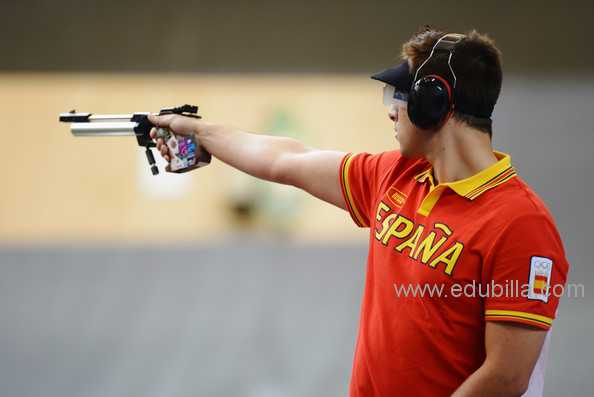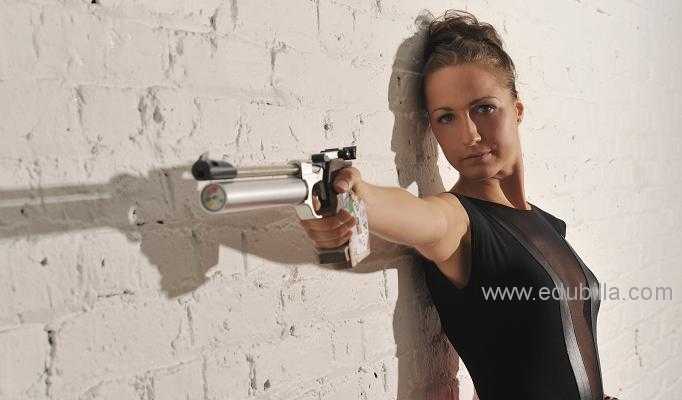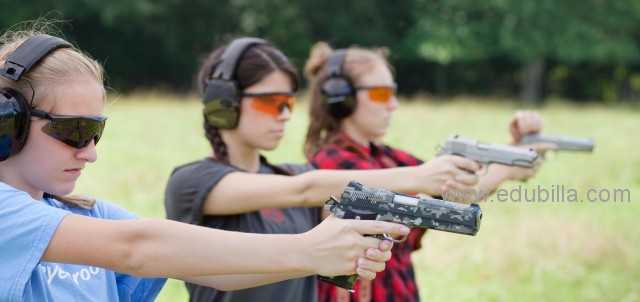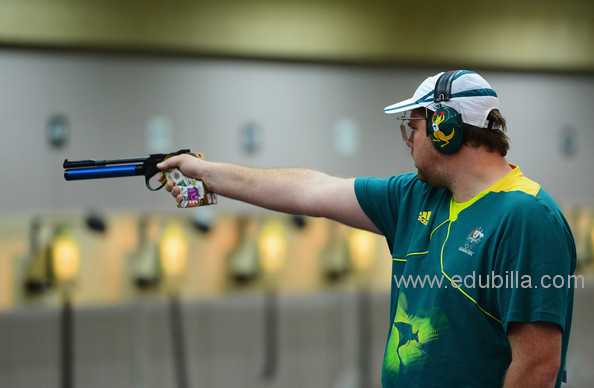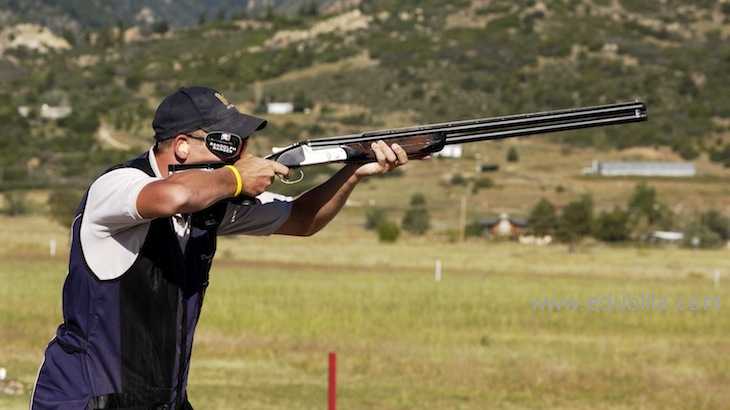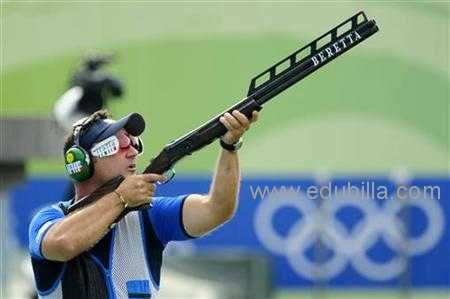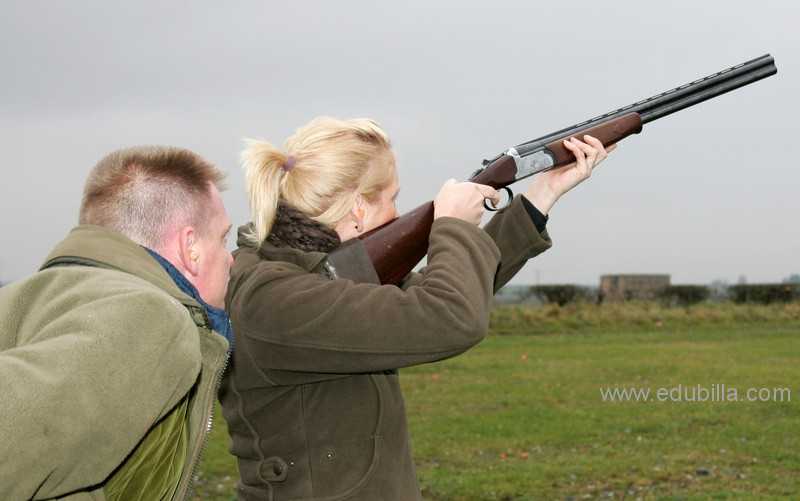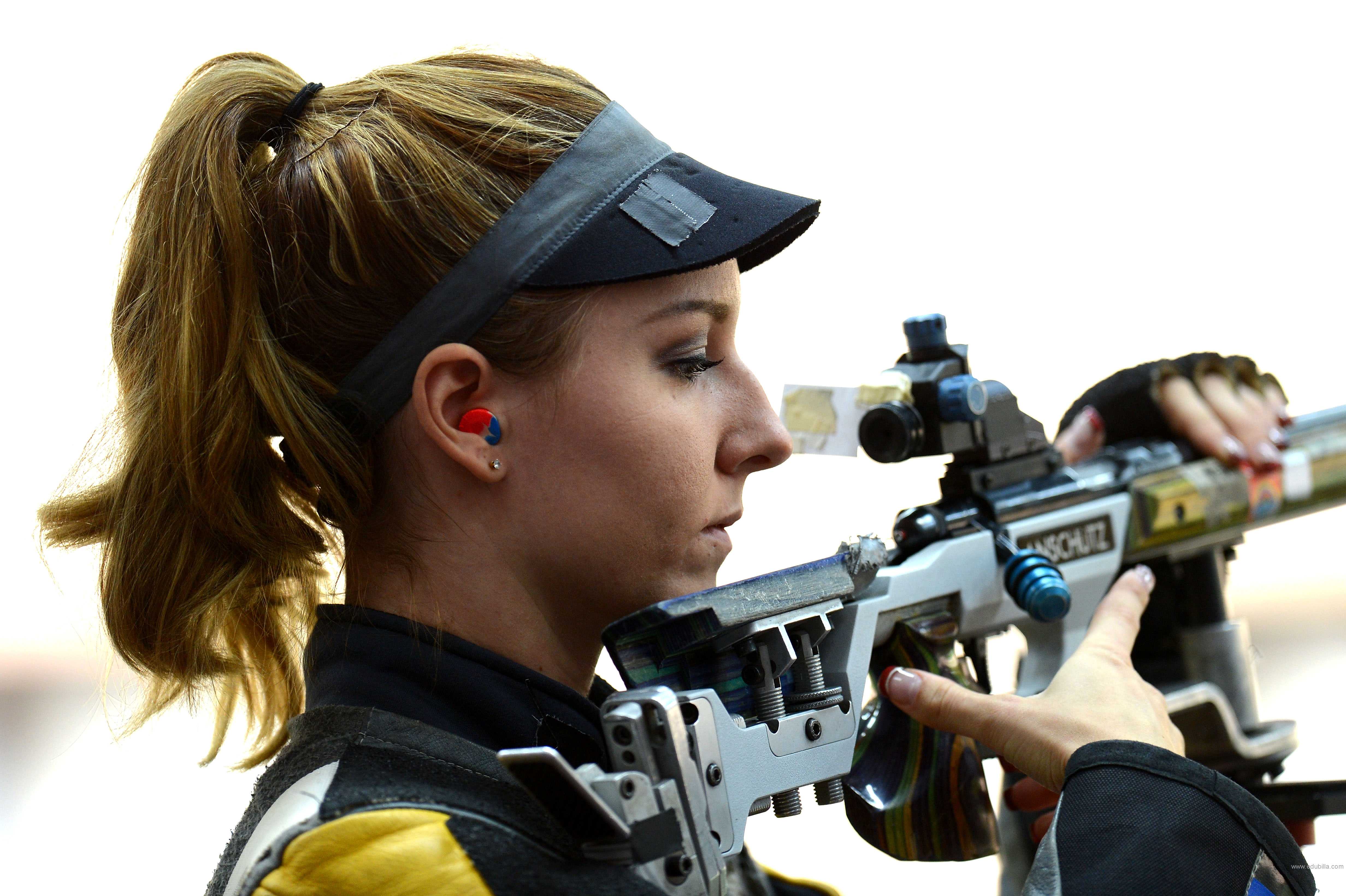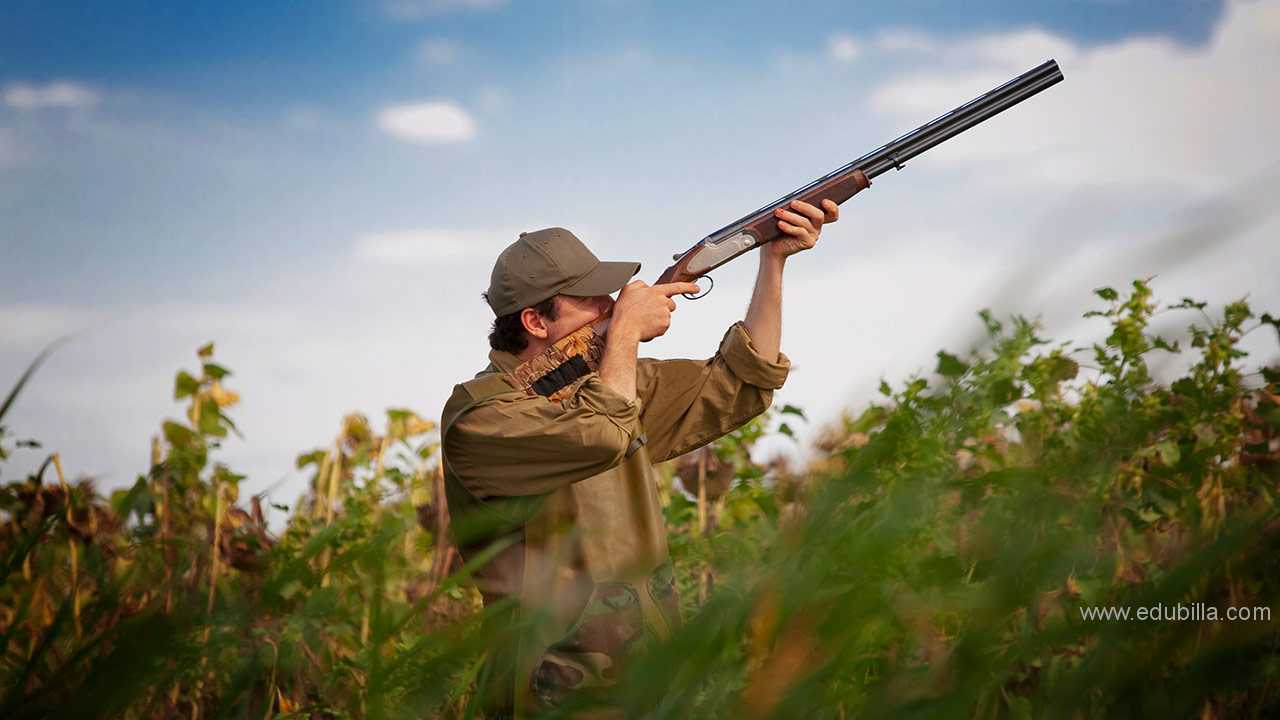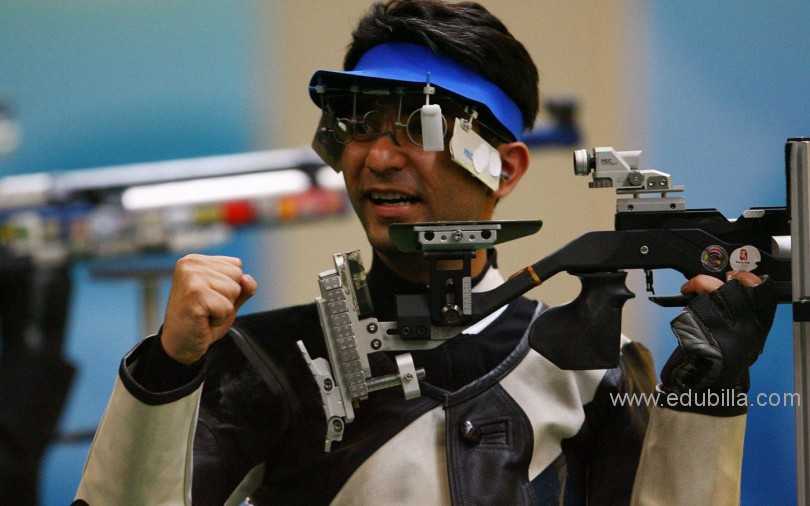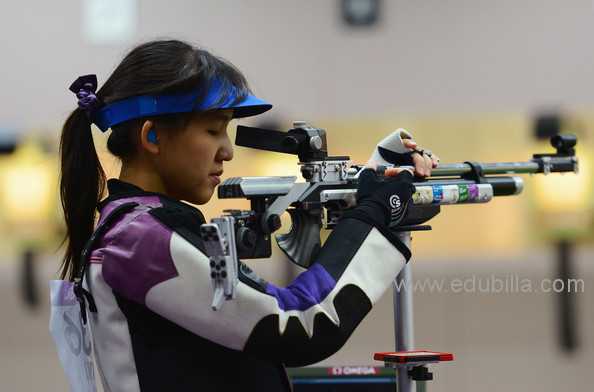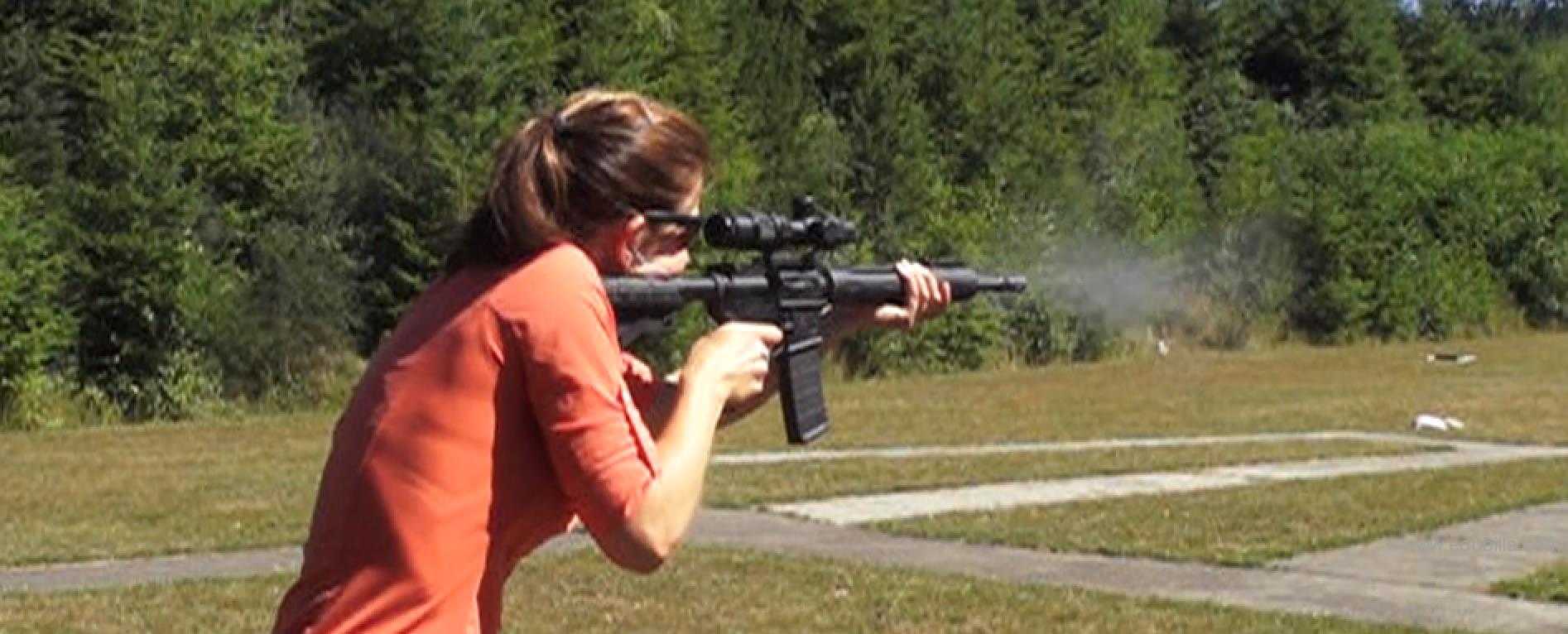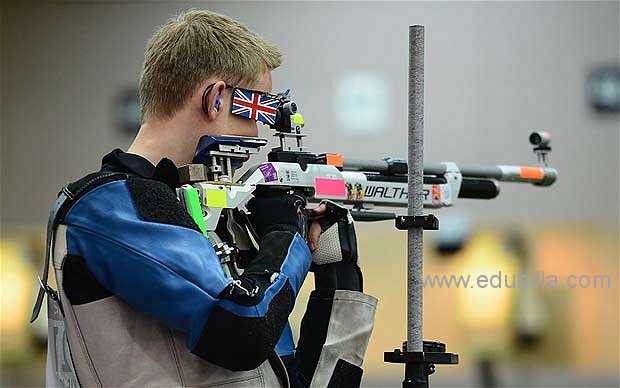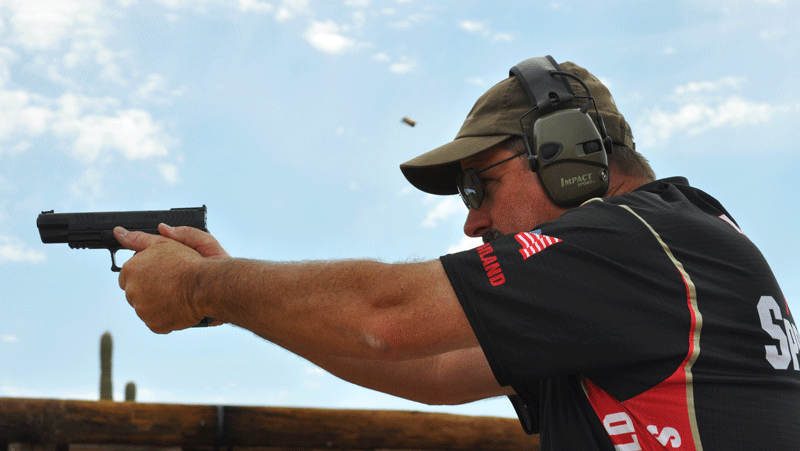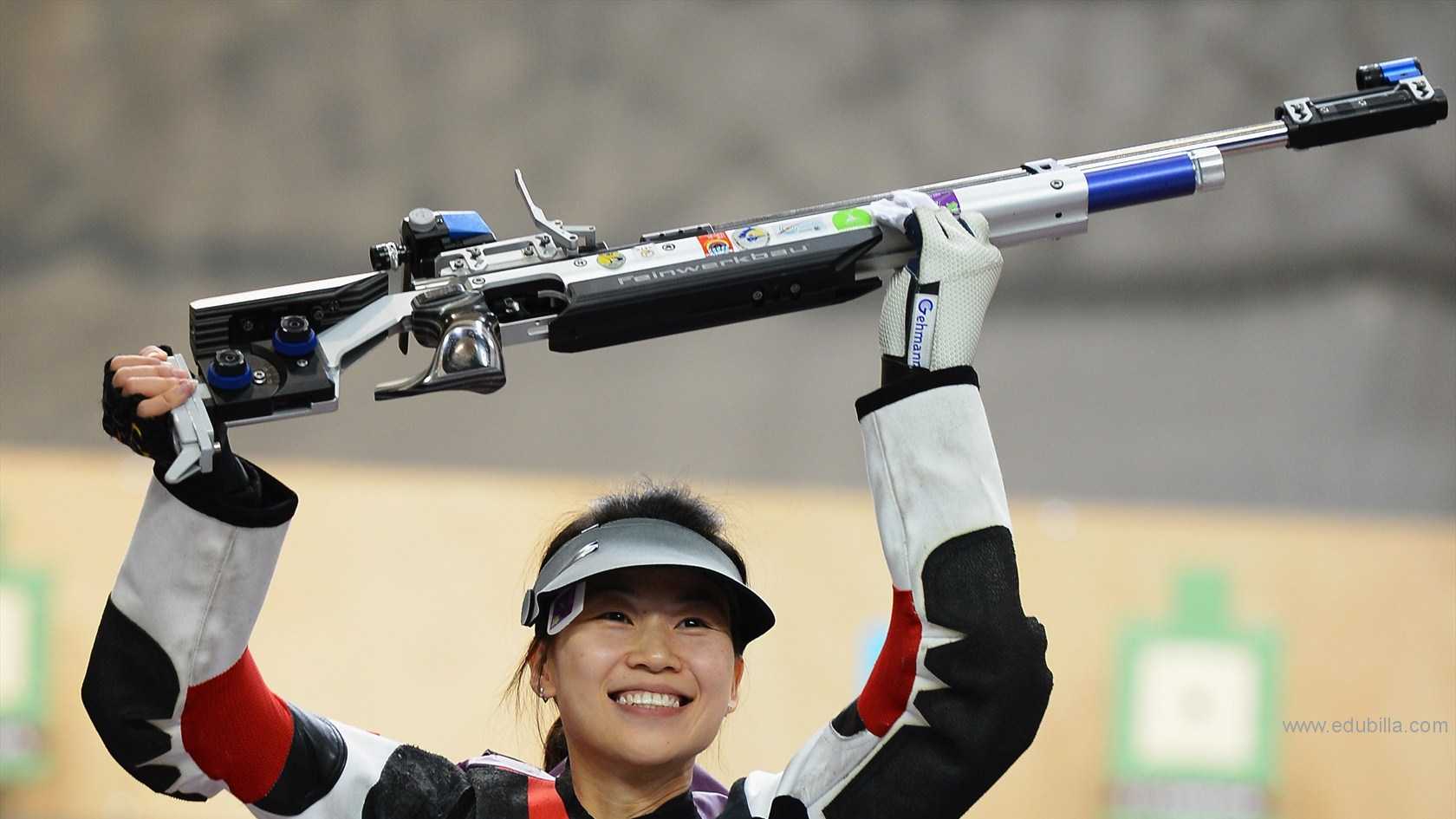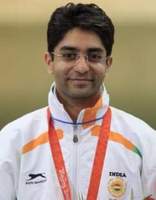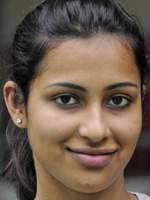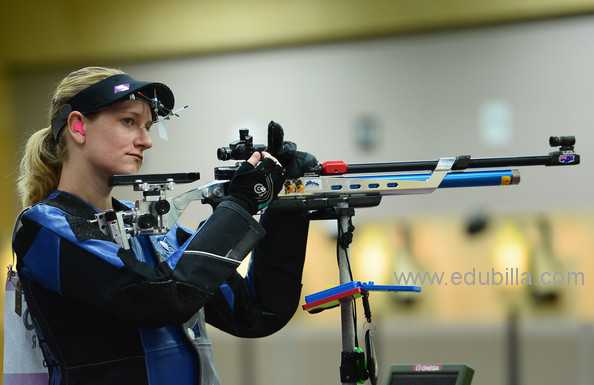
Overview Of Shooting
Shooting is the act or process of discharging firearms or other projectile weapons such as bows or crossbows. Even the firing of artillery, rockets, and missiles can be called shooting. A person who specializes in shooting is a marksman. Shooting can take place in a shooting range or in the field in hunting, in shooting sports, or in combat.
The sport of shooting is a challenge of accuracy and control, in which competitors use pistols or rifles to fire a series of shots at a stationary target. In this precision sport, athletes use focus and controlled breathing to reduce their heart rates and improve stability and high performance. This ability to steady hand and mind to deliver a sequence of shots requires well-developed powers of concentration and emotional control.
Shooting sport:
A shooting sport is a competitive sport involving tests of proficiency (accuracy and speed) using various types of guns such as firearms and airguns. Hunting is also a shooting sport, and indeed shooting live pheasants was an Olympic event (albeit only once, in 1900).The shooting sports are categorized by the type of firearm, targets, and distances at which the targets are shot.
Shooting at the Summer Olympics:
Shooting sports have been included at every Summer Olympic Games since the birth of the modern Olympic movement at the 1896 Summer Olympics except at the 1904 & 1928 editions.
Events:
- air pistol
- air rifle
- double trap
- pistol
- rapid fire pistol
- rifle prone
- rifle three positions
- skeet
- trap
School shooting:
A school shooting is an occurrence in which an individual or group of individuals launches a gun attack on an educational institution, such as an elementary school, secondary school, post-secondary institution, or at an education-related setting. The definition given from the report on school shooters by the Secret Service and Department of Education is "school shootings and other school-based attacks where the school was deliberately selected as the location for the attack and was not simply a random site of opportunity." A school shooting can happen anywhere in the world where a person takes a gun into a school setting. These shootings have sparked a political debate over gun violence, whether firearms should be allowed in the classroom and whether there should be stricter gun control.
Game Rules
Firearms Safety:
1. Always Keep The Muzzle Pointed In A Safe Direction
2. Firearms Should Be Unloaded When Not Actually In Use
3. Don't Rely On Your Gun's "Safety"
4. Be Sure Of Your Target And What's Beyond It
5. Use Correct Ammunition
6. If Your Gun Fails To Fire When The Trigger Is Pulled, Handle With Care!
7. Always Wear Eye And Ear Protection When Shooting
8. Be Sure The Barrel Is Clear Of Obstructions Before Shooting
9. Don't Alter Or Modify Your Gun, And Have Guns Serviced Regularly
10. Learn The Mechanical And Handling Characteristics Of The Firearm You Are Using
Gun Safety Rules:
1. Always Point a Gun in a Safe Direction.
This one should be self-explanatory. It is the bedrock of all gun safety, and is the most important rule. Another way to say it, which Dad taught me many years ago, is, "Never point a gun at anything you're not
2. Assume That Any Gun, at Any Time, is Loaded.
When someone tells you a gun is not loaded, that's fine - but don't believe it until you see it for yourself. If you offend your buddy by checking a gun after he's told you it's unloaded, then so be it. Better safe than dead. Make it a habit to check no matter what. This is a very important habit to get into.
3. Keep Your Finger off the Trigger.
This is something I see way too often. Some doofus will have his or her finger on the trigger of a gun they are simply carrying, looking down the sights of, etc. Don't do it! Keep that finger outside the trigger guard until you are ready to shoot, and after shooting, move it back out of the trigger guard. And please don't be offended that I used the term "doofus" if you have been guilty of this, because I have been a doofus before, too.
4. Know What You're Shooting at.
Your target is whatever you have decided to shoot. And - this is extremely important - it must be a conscious decision when you shoot something. Don't get lax about this. You need to know what you are going to shoot at, what is between you and it, and what is beyond it. Pay attention.
5. Be Familiar With Your Gun.
Take the time to learn about the operation and features of the firearm you are planning to use. The time to learn this is not while you are shooting... that is when you need to be learning about grip, shooting positions, trigger control, etc. When you step up to the firing line, you should already know how to operate the gun you'll be shooting.
6. Don't Shoot at Hard Surfaces (Including Water).
Water might not seem like a hard surface, but its density makes it pretty dangerous. It has a tendency to allow bullets and shotgun shot to ricochet (glance off) and fly off in an unintended direction. Not good. Hard surfaces like metal, rocks, and hard wood can do this too - and they can even send the projectile back to the shooter, which can be hard on a feller, because shooting oneself, even indirectly, can be a pretty nasty experience.
7. Don't Rely on a Safety Mechanism.
Many guns have a safety device to prevent the gun from firing. These are often reliable, but not always. And some guns have even been known to fire when the safety is released, most notably Remington bolt-action centerfire rifles, which naturally leads to the conclusion that safety mechanisms are often useful, but not completely reliable. Use the safety, but don't count on it! Continue to follow the number one rule: Always keep the gun pointed somewhere safe.
8. Load Your Gun When You Need to.
Some, including the NRA, will tell you to keep every gun unloaded until you're ready to fire it. This is not a sensible rule, because guns used for hunting and defense purposes will be needed in a hurry whenever they are needed, and there is no time to be messing around loading your gun when you need it to save your life, or to take the game you're hunting. If you need your gun for defense from human or animal attackers and it's not loaded, it becomes a liability rather than a benefit, and your safety goes down the tubes. So load your gun, and handle it responsibly.
9. Use the Right Ammo.
Make certain the ammunition you're using is right for your gun. Don't assume that you have the correct ammo just because it can be crammed into the gun. The groceries you feed your firearm need to match up with the gun's design and strength factors. The proper cartridge designation is usually marked on the gun. If you have any doubt, consult the gun's manufacturer or a qualified gunsmith.
10. Pay Attention!
It's easy to get distracted when you're having fun, and target shooting can be a lot of fun, especially if you're enjoying it with friends and family. Don't let yourself get carried away. Take extra care to follow safe gun handling rules, and don't be afraid to correct others when you see them improperly handling firearms - we all need a reminder every now and then. Some folks may not like to hear it, but all participants must follow gun safety rules if everyone is to come home safe and sound. And that's what we always want to see!
Equipments Need For Shooting
Air pistol:
A pistol that uses compressed air or carbon dioxide to discharge lead pellets.
Air rifle:
A rifle that uses compressed air or carbon dioxide to discharge lead pellets.
Airgun:
A rifle or pistol that uses compressed air or carbon dioxide to discharge lead pellets.
Barrel:
The tube of a gun.
Blinkers:
Devices sometimes affixed to the sides of shooting glasses to keep the wind out of shooters' eyes and prevent distraction from motion to the side.
Bunker:
A long concrete structure in front of a firing line from which machines throw clay targets in trap shooting; also known as a "trench".
Cartridge:
The complete unit of ammunition, including the projectile, case, powder and primer.
Chamber:
The rear portion of a gun barrel into which a cartridge is inserted for firing.
Choke:
A narrowed part of a shotgun barrel, as in a chokebore.
Chokebore:
A bore in a shotgun that narrows toward the muzzle to prevent shot from scattering too widely.
Clay target:
A saucer-shaped target of clay.
Metallic sight:
A non-magnifying device on the front or rear end of a firearm to assist aim.
Free pistol:
A .22-calibre pistol relatively free of specifications.
Magazine:
A receptacle for a number of cartridges which is inserted into a firearm and must be removed and replaced when empty.
Pistol:
A short firearm intended to be held and fired with one hand.
Rifle:
A shoulder firearm with spiral grooves cut in the inner surface of the gun barrel to give the bullet a rotating motion and render its flight more accurate.
Shotgun:
A smooth-bore firearm for firing round shot.
Stock:
The wooden, metal, plastic or fibreglass portion of a rifle or shotgun to which the barrel, action, trigger, etc. are attached.
Trap:
A device for suddenly releasing or tossing clay targets into the air in trapshooting.
Trench:
A long concrete structure in front of a firing line from which machines throw clay targets in trap shooting; also known as a "bunker".
Trigger:
A small projecting piece which, when pulled with the finger, operates the mechanism and discharges a firearm or air gun.
History Of Shooting
Shooting at a mark as a test of skill began with archery, long before the advent of firearms (c. 1300). Firearms were first used in warfare and later in sport shooting (hunting), and because of the shadowy early history of firearms, it is not known when target shooting began. The early history of the sport is largely that of shooting with rifles. The earliest recorded shooting match is one held in Eichstäat, Bavaria, in 1477; the shooters, probably using matchlocks, competed at 200 metres (220 yards).
A Swiss painting from 1504 shows a rifle shooting setup that is quite modern. Contestants fire from enclosed and covered shooting booths at targets in the background. Each target is flanked by a small hut in which a target marker would be concealed during shooting and would later signal by a staff or pole to the shooter and the judges the value of the hit. The judges and scorekeepers are in the right foreground at a table under a roof. Several wind flags are flying, and spectators are shown.
Gun clubs:
Shooting as a sport has been practised for hundreds of years in European countries, with some German shooting clubs dating back more than 500 years. The popularity of the sport grew in English-speaking countries with the formation of the National Rifle Association in 1959, which originally met in Wimbledon, London, and the National Rifle Association (USA) in 1871.
Choose your weapon:
There are 15 events in the Olympic programme, divided into three different groups: rifle, pistol and shotgun. The rifle and pistol competitions are held on shooting ranges, where marksmen aim at targets at distances of 10, 25 and 50 metres. In the shotgun event, competitors shoot at clay targets propelled at a series of different directions and angles.
Heartbeats and bullseyes:
Marksmen need to be as steady as possible to be accurate. In order to achieve this, they use relaxation techniques to drop their heartbeat to half its normal rate, fire between heartbeats and use blinkers to hit a bullseye, which appears as no more than a tiny dot in the distance.
International Shooting Union (UIT):
In 1907, eight nations established the International Shooting Union (UIT), recognized today as the world governing body for shooting. The U.S. joined the UIT in 1908. The organization is now based in Munich Germany, and has 148 member federations. Mexico’s Olegario Vazquez Rana currently serves as the UIT president. Wolfgang Schreiber edits the UIT Journal, published bimonthly in four languages. UIT Headquarters can be reached at 01149 89 53 10 12 (phone) or 011 49 89 5 30 94 81 (fax).
In 1978, the U.S. Olympic Committee selected the NRA as the sole national governing body for Olympic-style shooting in the United States. The NRA’s International Shooting Sports division has been designated to fulfill this responsibility from its headquarters office at the Colorado Springs Olympic Training Center. However, organizations such as the Amateur Trapshooting Association(ATA), the Pacific International Trapshooting Association (PITA), and the National Skeetshooting Association (NSSA) actively govern and develop American-style trap and skeet shooting in this country.
NCAA Championship:
The first NCAA championship in which women competed was the national college rifle shooting meet, two years before national championships were established for women's sports.
Division I members voted in favor of the national championship at the 1979 NCAA convention, only to learn that there were rifle teams at fewer than 45 schools, which was supposed to be the minimum number to warrant a national championship.
Nevertheless, the meet was held as a "pilot" event, April 4-5, 1980, at East Tennessee State University. It was considered a success, so it's been on the NCAA's annual schedule ever since.
Shooting has traditionally been a "co-educational"sport with men and women competing as equals. Women have won 18 of the 46 individual titles since the championship was inaugurated and a woman, Marsha Beasley, has coached 8 of West Virginia University's 13 championship teams.
Women in Olympic Shooting:
Margaret Thompson Murdock’s silver three-position victory at the ‘76 Games made her the first markswoman in history to win an Olympic medal. The event was open, meaning that men and women competed against each other.
Murdock’s success predated the institution of three separate women’s events at the 1984 Games in Los Angeles: women’s air rifle, women’s three-position rifle, and sport pistol. With her standout performance in women’s air rifle that year, American Pat Spurgin became the first markswoman in history to capture an Olympic gold. Ruby Fox (pistol) and Wanda Jewell (rifle) also won medals for the U.S. that year.
The number of female competitors has increased dramatically since 1984, and women’s participation is now growing at twice the rate of men’s. Separate men’s and women’s air pistol events were added to the 1988 Games in Seoul. And for the first time in history an all-women’s shotgun event, double trap, will join the Olympic program in 1996.
Origin Of Shooting
Formal target shoots involving the bow and arrow and the spear were first used as military training activities, but Homer’s "Iliad" indicates that Greeks also held archery contests to shoot pigeons on top of tall poles in honor of the gods. Indians, Persians, Slavs, Celts, and Germans engaged in similar activities.
By the tenth century, marksmanship evolved into a social and recreational sport. Regarded as the progenitor of great shooters, Swiss hero William Tell gained honor during the 14th century after successfully shooting an apple off his son’s head. A tyrannical Austrian bailiff forced Tell to use a crossbow to perform the legendary feat.
The First Shooting Clubs:
The first shooting clubs were formed by German-speaking peoples in the 13th and 14th centuries. Membership was limited to men only. At first, bows and wheel-lock muskets were shot from the standing position, but by the 16th century, firearms with rifled barrels were used in public matches. Early club competitions were festive one-shot matches fired at elaborately painted wooden targets. Matches and shooting festivals for one or more clubs were routinely held on New Year’s Day, religious holidays, and other special occasions. Prizes of gold and money were frequently awarded.
First School Shooting in Netherlands:
A 17-year-old student opened fire at ROC de Leijgraaf school, wounding three students and one teacher. One student was critically injured. It was the first school shooting in the history of the Netherlands.
The Beginning of World Competition:
The first World Shooting Championships were fired in 1897, when Lyon, France’s shooting club organized an international 300-meter rifle match to celebrate its 25th anniversary. Women’s events were first instituted at the 1958 Championships, and today World Championships for men and women in all disciplines are fired every four years. At the 1994 Championships in Milan 102 individual and team pistol, rifle, running target, and shotgun events will be contested.
The Emergence of National Federations and the UIT As shooting traditions devel0ped in the V.S. and overseas, many national federations were established in the mid to late 19th century. The National Rifle Association of America (NRA) was founded in 1871 by Colonel William Church and Captain George Wingate of the New York National Guard. The U.S. Revolver Association, founded in 1900, actually selected, trained, and financed Olympic pistol teams through the 1936 Games. The NRA then assumed leadership and developmental responsibilities for pistol, rifle and, beginning in 1960, shotgun shooting in the U.S.
Shooting In India:
The origin of shooting in India can be traced back to the medieval period, when Indians used to practice the game in the form of archery. During the 16th century, the firearms were introduced to the game, which was primarily used for hunting. Shooting competitions were held right from the 11th century, although the game was considered royal, confined to the Maharajas of the princely states of India. They were fond of shooting and frequented the woods, to hunt prey, using their rifles. Over the passing years, the game secured its place in the military training as well.
National Rifle Association of India:
The National Rifle Association of India (NRAI) came into existence in 1951, which paved the way for the recognition of shooting as a sport in India. The establishment of NRAI proved beneficial for the shooters in India, who were given international exposure. NRAI organizes various shooting competitions at the national level, under four disciplines - rifle, pistol, shotgun and running target. With the increasing popularity of the shooting sport in India, the budding shooters are putting strenuous efforts to excel in the game and gain recognition both at the national and international levels.
Governing Bodies
International Shooting Sport Federation (ISSF):
The International Shooting Sport Federation (ISSF) was founded in 1907 as the International Shooting Union, changing its name in 1998. Shooting has been contested since the inaugural modern Olympic Games in 1896.
Olympic expansion:
Shooting has come a long way since its debut at the inaugural Games in 1896. Originally, there were just three shooting events compared to the 15 currently on the Olympic programme. In part, this leap is thanks to advances in the technology of firearms and equipment, but it is also a reflection of the passion shooters have for their sport.
Current events:
At the Olympic Games, there are nine events for men and six for women. The events are divided into three groups: rifle, pistol and shotgun. The rifle and pistol events are held on shooting ranges, with competitors aiming at targets from distances of 10 metres, 25 metres and 50 metres. In the shotgun event, competitors shoot at clay targets propelled in a series of different directions.
Women in the ranks:
In 1992, 24-year-old Chinese competitor Zhang Shan sensationally won gold in a mixed-gender Skeet shooting event. In doing so, she became the first woman ever to win gold in an Olympic event open to both men and women. In 1996 at the Atlanta Games, the shooting programme was segregated, so her achievement could remain unique for a very long time.
The ISSF History Milestones:
19th century – During the 19th century, earlier forms of organizations such as shooting clubs developed into national shooting federations. The Société Suisse des Carabiniers was founded in 1824 in Switzerland; Queen Victoria inaugurated the British National Rifle Association in 1859. Duke Ernst II of Saxony-Coburg and Gotha founded the Deutscher Schützenbund in 1861, and military leaders established the National Rifle Association of America (USA) in 1871.
The Federation Francaise des Societies de Tir was formally established in 1884, but earlier French national federations had preceded it.
1896 – The shooting sport began part of the modern Olympic Family since its first steps. In the first Olympic Games, held in Athens in 1896, 39 shooters from seven nations competed in three pistol and two highpower rifle events. Shooting also was included in the program of the second Olympic Games where 139 shooters from 13 nations competed in three pistol, five rifle, two clay target and one running target events.
1907 – On 17 July 1907, representatives of seven national shooting federations, six from Europe (Austria, Belgium, France, Greece, Italy, Holland) and one from South America (Argentina), met in in Zurich, Switzerland, to formally establish the L’Union Internationale des Fédérations et Associations nationals de Tir (International Union of National Shooting Federations and Associations) in a meeting that would be remembered as the first ISSF General Assembly.
The President of L’Union des Sociétés de Tir de France, Daniel Mérillon, a 55-year old lawyer from Paris, was elected as the first ISSF President.
1908 – The second General Assembly of the ISSF history took place in Vienna, during the International Matches. Three new member federations from England, Germany and Hungary, were also represented. The Swiss shooting federation, after the first indecisions, joined the union at the General Assembly. Later on, during the year 1908, USA would joint the union.
1909 – The shooting family grows, and more national federations join the union. Between 1909 and 1914, Serbia, Denmark, Spain, Portugal, Sweden, Peru, Mexico and Finland become members of the Union Internationale, following the desire by the first ISSF leaders to make their organization a world sports federation.
1912 – 284 shooters, coming from 16 different countries, participated in the 1912 Olympic Games of Stockholm, Sweden, in 15 total events, two pistol, eight rifle, two shotgun and three running target.
1916 – The 1st World War in Europe caused the cancellation of the 1916 Olympic Games which were to take place in Berlin, and the next ISSF International Matches which were to take place in 1916. President Mérillon circulated a written proposal to the member federations and the decision was made, by a vote of ten to six, to dissolve the Federation. L’Union des Sociétés de Tir de France was entrusted with the care of the ISSF records and property.
1920 – President Mérillon invited the national federations that were members in 1915 and federations representing new countries formed after the war to come to a meeting in Paris on 16 April 1920 to renew ISSF activities. Delegates from 14 countries attended and agreed to reestablish the ISSF under the name L’Union Internationale de Tir (UIT). Mérillon was reelected President of the Union.
1921 – IOC – International Olympic Committee - decided in 1921 that ISSF regulations were to govern the shooting events in the 1924 Games. This was the first concrete step in forging a union between the ISSF and the IOC that was to have such a profound impact on the Federation’s future.
1924 – The shooting events of the Paris Olympiad used ISSF regulations and were organized by L’Union des Sociétés de Tir de France. Over 260 athletes from 27 nations participated in the Olympic shooting events.
1927 – After the premature death of Mérillon, his son-in-law Jean Carnot was elected as the second ISSF President in a divided vote at the General Assembly held in Rome in 1927.
1928 - A crisis in the ISSF’s relationship with the IOC occurred between the years 1926 and 1928. The practice of awarding money prizes in ISSF World Championships clashed with strict IOC amateur standards. As a result, the IOC excluded shooting from the 1928 Olympic Games in Amsterdam. At its 1928 General Assembly, ISSF delegates approved an appeal to the IOC to reinstate shooting to the 1932 Olympic Games program.
1932 - Shooting was re-included on the Olympic program of the Games of Los Angeles, but the number of the events was greatly reduced. There were only two shooting events, one rifle and one pistol. 41 athletes from 10 countries took part, but many of the world’s best marksmen were not there because their acceptance of money prizes in other competitions made them incompatible with the IOC amateur standards.
1936 - Shooting was again on the Olympic program in Berlin in 1936, this time with three events, a smallbore rifle 50 meter 30-shot prone event and two pistol events, the traditional 50 meter free pistol event and the new 25 meter rapid-fire pistol event that had been tested at the 1933 World Championship.
1937 – The year 1937 saw the first participation of a Woman in an open World Championship event. Catherine Woodring fired as a member of the USA team, winning the 50-meter rifle prone gold team medal.
1940 – Olympic Games of Helsinki could not take place: the Second World War was exploded. For the second time in the ISSF’s short history, a decision was made to suspend operations.
The ISSF records and archives were transported by Karl August Larsson, Secretary General of the Swedish shooting federation, from Paris to Stockholm, where they could be protected in a neutral nation.
1947 – After the conclusion of the Second World War, eight member federations agreed on holding a World Championship and a General Assembly in Stockholm in 1947. There, Erik Carlsson, President of the Swedish shooting federation was elected as the third ISSF President and Karl August Larsson as its Secretary General.
1948 – 300m Rifle event returns at the Olympic program of the 1948 Games after missing since 1924
1951 – The Pan American Games and Asian Games were both created as multi-sport international competitions like the Olympic Games, on their respective continents in 1951. Shooting was accepted as a sport in both. Pan American and Asian Games, with shooting included, have been staged every four years since 1951.
1954 – The 1954 World Championship returned to South America for the third time in ISSF history when it took place at Caracas, Venezuela. Thereafter, a four-year cycle for World Shooting Championships was adopted.
1955 – The first European Shooting Championship was held in 1955 in Bucharest, Rumania. The European Shooting Confederation was formally organized in 1958 and has continued to organize European Championships on an annual or bi-annual basis since.
1958 – Men’s Skeet event was added at the ISSF program.
1960 – At General Assembly that took place at Rome during the 1960 Olympics, President Carlsson, who had served for 14 years, decided not to be a candidate for reelection. The assembly, which was attended by delegates from a record 55 countries, elected Dr. Kurt Hasler, who was President of the Swiss shooting federation, as the fourth ISSF President.
1966 - The ISSF recognized all of its open events as “mixed” events where women could participate with men in 1966. The IOC also agreed to apply this standard to Olympic shooting events. For four Olympiads, from 1968 through 1980, the Olympic shooting events were mixed, with opportunities for women and men to participate regardless of gender.
1966 – Air Rifle event was added at the ISSF program.
1970 – Air Pistol event was added at the ISSF program.
1975 – Mr. Olegario Vazquez Raña was elected President of the Mexican Shooting Federation.
1976 – President Kurt Hasler, after serving the ISSF fort 16 years, decided not to stand for reelection. The leading candidate was First Vice President George Vichos, a lawyer from Athens, Greece, who won an election decided by just one vote in his favor.
1978 – In 1978, the ISSF General Assembly elected several new Administrative Council members including Olegario Vazquez Raña, President of the Mexican Shooting Federation.
1979 – Olegario Vazquez Raña was elected as President of the Confederación Americana de Tiro (CAT).
1980 – During the ISSF General Assembly of the XXII Olympiad that was held at Mexico City in 1980, Olegario Vazquez Raña emerged as the leading candidate to be the next ISSF President. Vazquez Raña was an active, successful shooter who competed for Mexico in four Olympic Games (1964, 1968, 1972, 1976) and five World Shooting Championships (1966, 1970, 1974, 1978, 1979).
When the day to elect a new ISSF President came in February 1980, Olegario Vazquez Raña was elected as the sixth ISSF President with 125 of the 132 votes present at the Assembly.
The 1980 General Assembly also elected a new Secretary General, Mr. Horst G. Schreiber, a prominent attorney in Munich, Germany who had successfully served in leadershop roles in the sports of shooting, golf and tennis.
1980 – The General Assembly established the ISSF Women’s Committee that took the place of the 1977’s provisional Ladies Committee.
1984 – Ms. Unni Nicolaysen, the Secretary General of the Norwegian shooting federation, became the first woman in the 77-year history of the Federation to be elected to membership on the Administrative Council, a body with real decision-making power.
1984 - The IOC agreed to add three women’s events, 10 meter air rifle, 50 meter small-bore rifle 3x20, and 25 meter sport pistol, to the 1984 Olympic Games program.
1986 – Following the invitation of the IOC, the ISSF develop an Olympic qualification system.
The ISSF established a new series of World Cups, included them in the Olympic qualifying system, and recognize scores fired in World Cups as World Records. The first ISSF World Cup Rifle and Pistol was held in Mexico City, Mexico in March 1986 followed by the first ISSF World Cup Shotgun set in Montecatini, Italy, in April 1986.
1987 –Starting from that year, an annual World Cup Final where the shooters with the best scores in that year’s ISSF World Cups were invited to compete in a “champion-of-champions” competition at the end of each year and it became a new fixture on the ISSF Championship calendar.
1988 – The 10 meter Air Pistol Women Event was added to the 1988 Olympic program of the Seoul Games.
1993 – The ISSF established the Training Academy in 1993. By conducting regular courses in several locations, the ISSF Academy has now trained over 400 shooting coaches from 74 different national federations.
1994 – The ISSF General Regulations recognize 15 junior men’s events and 10 junior women’s events that were added to the program of the ISSF World Championships.
1996 – A shotgun event, double trap women, was added to the 1996 Olympic Games program.
1998 – At the 1998 General Assembly in Barcelona, the word “sport” was formally incorporated into the ISSF’s modern name, “International Shooting Sport Federation.”
2000 – Following the introduction of the double trap women event at the previous Games of Atlanta, two additional women’s shotgun events, trap and skeet, were added to the program of Sydney 2000.
2004 – The Olympic Games of Athens saw a record participation of 106 countries, presenting 390 shooters to compete in 17 events.
2006 - The most recent World Championship in Zagreb, Croatia in 2006, saw a record of participations: 1932 athletes from 97 countries were hosted in Zagreb. With the junior events, there were 54 individual and 51 team events.
2007 – Twenty years after the foundation of the ISSF World Cup series, at the 2007 Munich World Cup Rifle and Pistol 834 athletes from 81 countries participated.
2008 – The Olympic Games of Beijing saw the participation of 103 countries, presenting 390 shooters to compete in 15 events (9 men and 6 women), in the disciplines of Rifle, Pistol and Shotgun. Following what the IOC President Jacques Rogge called "a tradition", the first Gold medal of the XXIX Olympiad was assigned to the Shooting sport. On August the 9th, Czech's Katerina Emmons became the first Olympic Gold medallist of the Olympic Games of Beijing 2008 by winning the 10m Air Rifle Women event.
2012 - 390 athletes coming from 108 nations competed in 15 Olympic Shooting events (9 men and 6 women), in the disciplines of Rifle, Pistol and Shotgun, at the XXX Olympic Games in London. The competitions were held at the Royal Artillery Barracks from the 28th of July right through the 6th of August. Following a long-lasting traditions, Shooting Sport assigned the first Gold medal of the Games, which went to Yi Siling of the People's Republic of China, the winner of the 10m Air Rifle Women event.
2013 - Following the London Games, the ISSF introduces major changes to its rules. Olympic Shooting events' finals will from now on start from zero: the qualification score is not carried forward into the Finals anymore. Shotgun events see the introduction of semi-finals and medal matches. Rifle and Pistol Finals are now conducted elimination-style
To Visit ISSF Click Here.
Awards Related To Shooting
Arjuna Award:
The Arjuna Awards are given by the Ministry of Youth Affairs and Sports, government of India to recognize outstanding achievement in National sports. Instituted in 1961, the award carries a cash prize of 500,000, a bronze statuette of Arjuna and a scroll.
Rajiv Gandhi Khel Ratna Award:
The Rajiv Gandhi Khel Ratna (RGKR) is India’s highest honour given for achievement in sports, given by the Ministry of Youth Affairs and Sports, government of India.The words "Khel Ratna" literally mean "sports gem" in Hindi. The award is named after the late Rajiv Gandhi, former Prime Minister of India. It carries a medal, a scroll of honour and a substantial cash component. Up to 2004–05, the cash component was Rs. 500,000/- (c.11,500 USD). In 2005, the money has been increased from Rs. 500,000 to Rs. 750,000.
Padma Bhushan Award:
The Padma Bhushan is the third highest civilian award in the Republic of India, after the Bharat Ratna and the Padma Vibhushan, but comes before the Padma Shri. It is announced on the occasion of Republic Day of India every year. It is conferred by the President of India at a function held at Rashtrapati Bhavan sometime around March/ April.
Dronacharya Award:
Dronacharya Award is an award presented by the Ministry of Youth Affairs and Sports, government of India for excellence in sports coaching.The award comprises a bronze statuette of Dronacharya, a scroll of honour and a cash component of Rs.300,000. The award was instituted in 1985.
As the best sportsperson award is named Arjuna Award, it is appropriate that the coaching award is named after Dronacharya, as he was the teacher of Arjuna. B.I. Fernandez is the first foreign coach to be awarded Dronacharya Award.
Times of India Sports Awards:
The Times of India Sports Awards or TOISA will honour sportspeople across multiple disciplines, laying the foundation of a world-class sports awards in India.
Sample Documents Of Shooting
-Muhammad Ali

